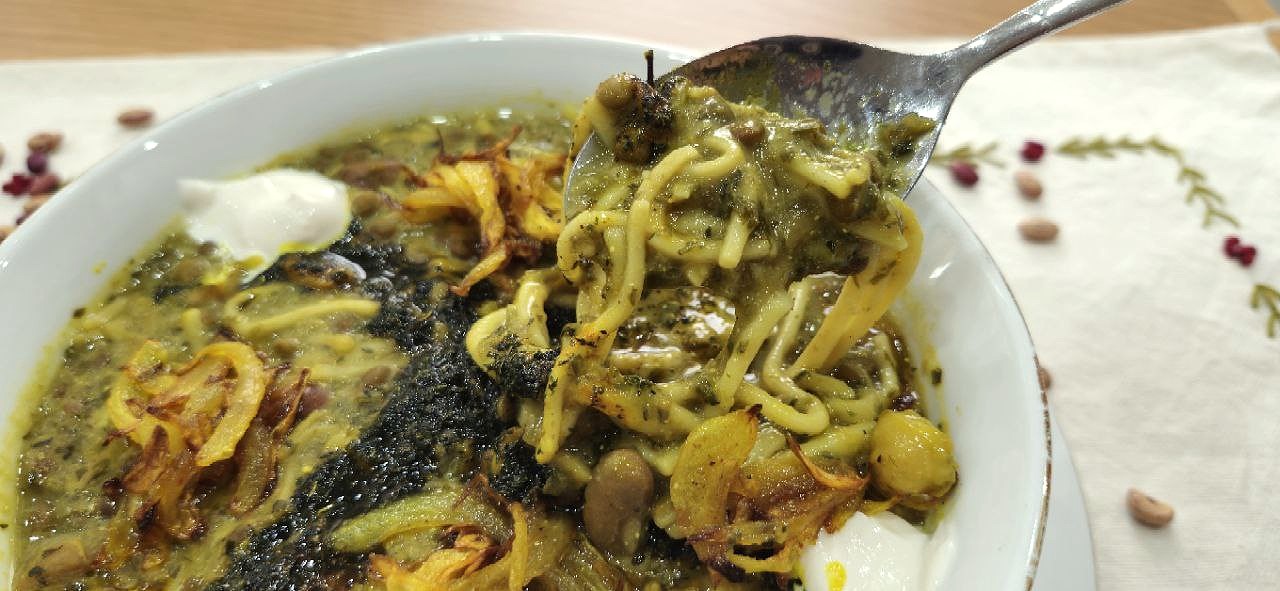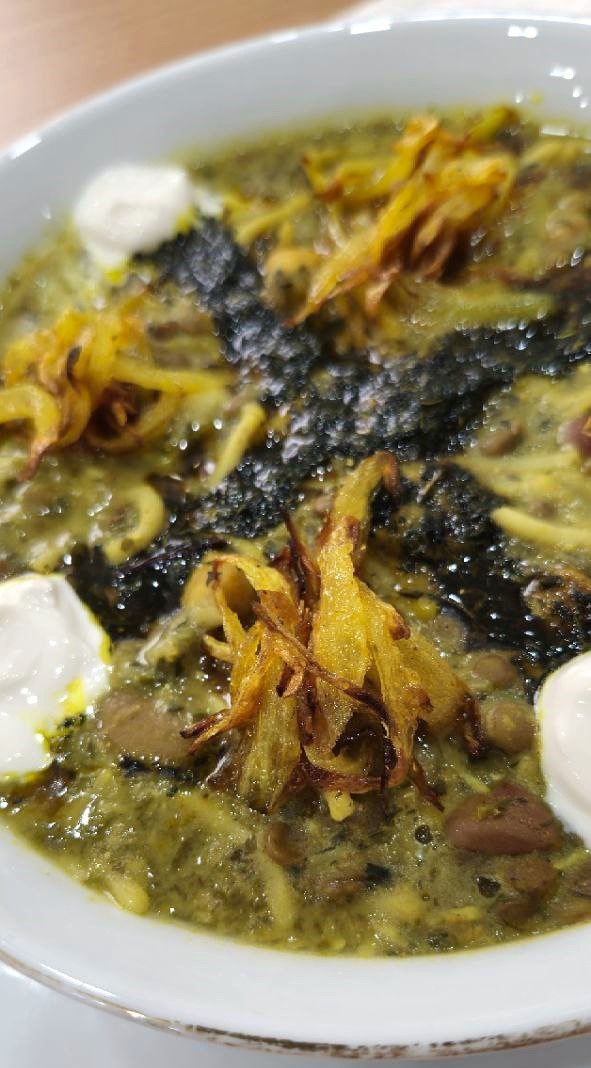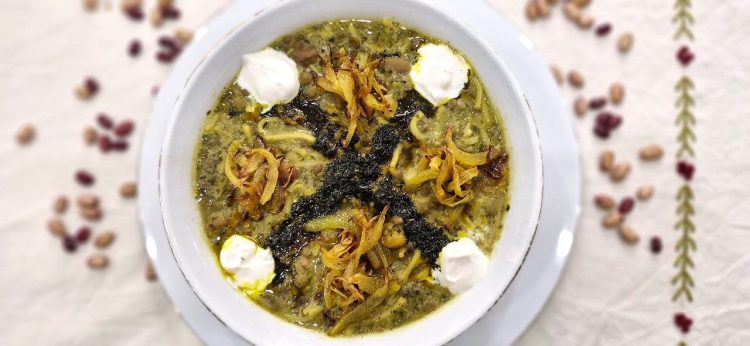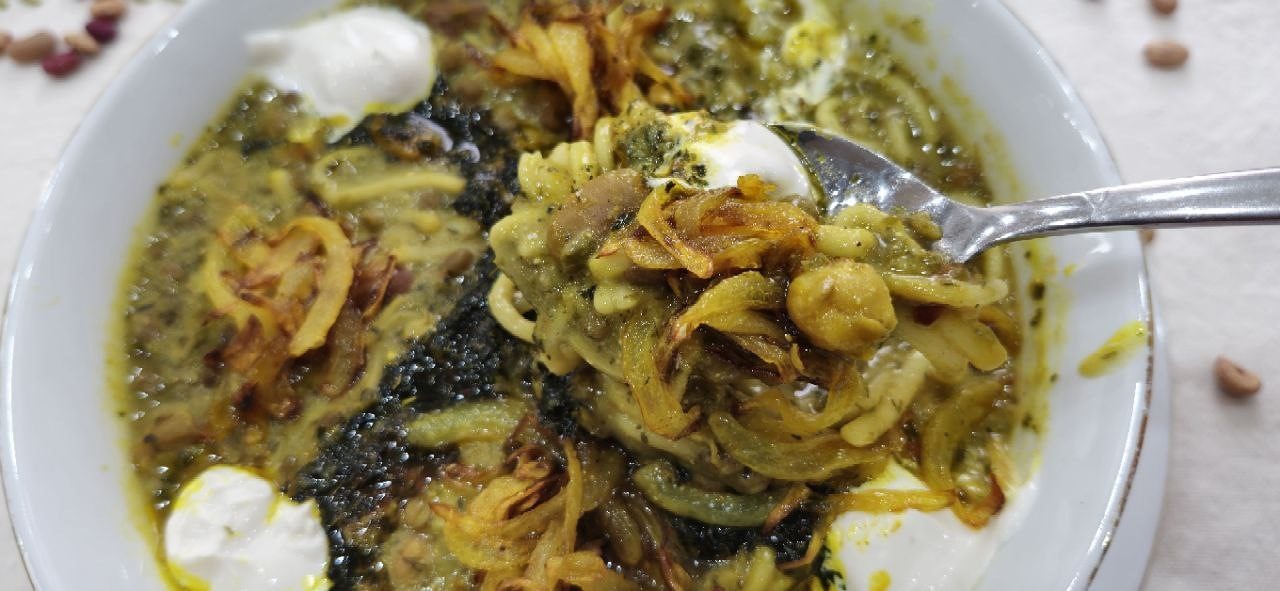Ash Reshteh
Ash Reshteh is one of those Persian comfort foods that feels like a warm hug in a bowl. I still remember the weekends when I used to live in southern Iran — our close-knit group of family friends would head to the beach for a picnic almost every Friday. Among all the delicious things we shared, a big pot of Ash Reshteh always stole the spotlight. Savoring this hearty noodle and herb soup by the sea, surrounded by laughter and the sound of waves, made it even more special. It wasn’t just food — it was part of our weekend ritual, and every spoonful came with a memory.
What is Ash?
If you’ve never heard of Ash Reshteh, you’re not alone — most people outside of Iran haven’t! In Persian cuisine, “Ash” refers to a thick, hearty soup that’s packed with herbs, legumes, and sometimes noodles or grains. There are many kinds of Ash in Iran, but Ash Reshteh is one of the most beloved. It’s made with a mix of fresh herbs (like parsley and cilantro), beans, and reshteh — traditional Persian noodles. The whole dish is topped with a drizzle of tangy whey sauce (called kashk) and crispy fried onions, making it rich, flavorful, and deeply comforting. It’s the kind of food that warms both your body and your soul.
What Is Ash Reshteh?

Ash Reshteh is one of the most comforting and iconic Persian noodle soups — a hearty dish that’s loved in nearly every Iranian household. It’s packed with fresh herbs, legumes like chickpeas, lentils, and beans, along with traditional Persian noodles (reshteh), caramelized onions, and garlic. It’s typically served with a generous swirl of kashk (fermented whey) on top. While some enjoy it as a cozy appetizer, others serve it as a filling main dish. Ash Reshteh is especially popular in winter, at family gatherings, during Sizdah Bedar (the Persian outdoor picnic day), and as a warm, satisfying option for iftar during Ramadan.
How to Make Persian Ash Reshteh at Home?
Ash Reshteh is one of those comforting Persian soups that’s packed with herbs, legumes, and noodles. You start by soaking and cooking the beans, then add fresh herbs and Persian-style noodles to build flavor. It simmers slowly until thick and hearty. Finally, it’s topped with crispy fried onions, golden garlic, mint oil, and creamy whey (kashk) for that signature taste everyone loves.

Step 1: Preparing the Legumes
The most important step in making Ash Reshteh is soaking the legumes, which helps them cook faster and become easier to digest. Each type of legume—such as chickpeas and beans—is placed in separate bowls, covered with water, and left to soak for 5 to 6 hours. During this time, the water should be changed twice to reduce any digestive discomfort caused by the legumes.
For the chickpeas, after about 3 hours, change the water again, add a generous amount of salt, cover with fresh water, and let them soak overnight to further reduce any bloating.
For the beans, change the water after around 2 hours, add a small cucumber to the soaking water, then cover and soak overnight. This traditional trick helps eliminate the beans’ gas-producing effects.
Step 2: Cooking the Chickpeas and Beans
First, drain and rinse the soaked chickpeas, then place them in a large pot with 4 to 5 cups of water. Cook them over medium heat until they begin to soften.
In a separate pot, put the soaked beans and add about 5 cups of water.
Step 3: Simmering the Legumes
Next, place both pots on the stove and turn the heat up to bring the water to a boil. Once boiling, skim off any foam that forms on top of the legumes with a spoon. Then reduce the heat to low and partially cover the pots with lids, leaving a small gap for steam to escape. Let the chickpeas and beans cook slowly until tender, but be careful not to overcook them — they shouldn’t become too soft or fall apart.
Step 4: Finishing the Legumes and Soaking the Lentils
Once the chickpeas and beans are cooked but still hold their shape, remove them from the heat and set them aside. Meanwhile, place the lentils in a bowl, cover them with water, and let them soak for about 30 minutes.
Step 5: Preparing the Herbs
Clean and wash the herbs used for Ash Reshteh (typically parsley, cilantro, spinach, and green onions). Drain them well using a colander, then spread the herbs on a clean kitchen towel and let them dry completely. Once dry, roughly chop the herbs using a food processor or a cutting board — they should be chopped coarsely, not finely. Set them aside for later use.
Step 6: Preparing the Onions
Peel and wash the onions, then dice them finely on a cutting board. Heat some oil in a pan over low heat until warm, then add the onions. Sauté them gently until they turn golden brown and fragrant. Once done, transfer the onions to a plate.
Step 7: Preparing the Garlic
While the onions are cooking, peel, wash, and chop the garlic. After removing the onions, add the garlic to the same pan (add a little more oil if needed). Sauté the garlic until lightly golden, being careful not to overcook it — this helps preserve its flavor and health benefits. Once cooked, transfer the garlic to a plate.
Step 8: Frying the Dried Mint
Check the pan immediately; if there’s no oil left, add some more and reduce the heat to low. Add the dried mint to the pan and sauté it gently. Once the mint starts to change color slightly, remove the pan from the heat. Keep stirring the mint to prevent it from burning or turning black.
Step 9: Starting the Soup Base and Adding Lentils
In the pot prepared for cooking the soup, fill it about one-third full with water and cover it with a lid. Place it over high heat to bring the water to a quick boil. When the water starts boiling, rinse the soaked lentils in a colander, then add them to the boiling water.
Step 10: Adding Cooked Chickpeas, Beans, and Herbs
Carefully add the cooked chickpeas and beans to the boiling water. When you add the legumes, the water may stop boiling temporarily—wait until it returns to a boil before moving on. Then add the prepared herbs, and immediately sprinkle in half a teaspoon of salt.
Step 11: Adding Fried Ingredients and Simmering
(We add salt at this stage to help preserve the vibrant color of the herbs.) Next, add half of the fried garlic, fried onions, fried mint, and a pinch of turmeric to the pot. Do not cover the pot with a lid. Let the soup simmer gently over medium heat for 30 to 45 minutes, allowing the herbs to cook through.
Step 12: Adding the Noodles and Adjusting Flavor
After the herbs are cooked, break the Persian noodles (reshteh) into smaller pieces and add them to the soup. Let it cook for another 15 to 20 minutes. Taste the soup and add more salt if needed.
Step 13: Adding Kashk and Final Seasoning
Next, add the kashk and taste the soup again. If necessary, season with a little black pepper and additional salt. Throughout the cooking process, if the soup becomes too thick or the water level drops, add some boiling water to maintain the right consistency without affecting the flavor. Serve the finished Ash Reshteh in bowls and garnish generously with fried onions, fried garlic, fried mint, and extra kashk on top.
What is kashk ?
One of the key ingredients that gives Ash Reshteh its signature flavor is kashk — a traditional Persian dairy product made from drained yogurt or whey. It has a salty, slightly tangy taste and a creamy, rich texture. Kashk is usually stirred into the soup or drizzled on top before serving, adding a delicious depth to the dish. If you can’t find kashk at your local Middle Eastern market, you can try mixing Greek yogurt with a bit of sour cream and salt as a quick alternative. While it won’t be exactly the same, it comes surprisingly close to the flavor and texture of real kashk.
Important Tips for Cooking Ash Reshteh
- Be careful when adding fried dried mint (na’na-ye dagh); too much can make your Ash Reshteh taste bitter or unpleasant.
- Do not add salt while cooking the legumes, as it can slow down their cooking process.
- To prevent the noodles from sticking together, use a pot that is large enough to hold the soup comfortably—make sure the pot size matches the quantity of Ash Reshteh you are preparing.
- Since lentils cook faster, it’s best to cook them separately in another pot.
- Keep in mind that the noodles and kashk are slightly salty, so be cautious when adding salt to the soup.
- If the soup becomes too thick or stiff after adding the noodles, add some boiling water to adjust the consistency.
- When chopping the herbs, it’s better to chop the leek separately from the other herbs.
- To achieve a nice, thick texture, keep the heat low so the soup cooks gently and evenly.
- For a richer taste and better color, add hot boiled kashk to the soup at the end.
Ash Reshteh Recipe
Ash Reshteh is a classic Persian noodle soup made with herbs, legumes, and a swirl of kashk on top. It’s hearty, flavorful, and perfect for cozy days—let’s make it step by step!
Ingredients Ash Reshteh
½ cup white beans
½ cup pinto beans
¾ cup chickpeas
1½ cups lentils
500 grams fresh Persian herbs for Ash Reshteh, including parsley, cilantro, spinach, and leek
8 cloves garlic
2 large onions
2 tablespoons dried mint
500 grams traditional Persian noodles called reshteh
Kashk (fermented whey), to taste
Salt and black pepper, to taste
Turmeric and cooking oil, as needed
Directions
- Cook the legumes
Cook chickpeas and beans separately until partially tender. - Prepare the herbs
Wash, dry, and coarsely chop the herbs. - Make the toppings
Fry onions and garlic separately, then lightly sauté dried mint. - Cook the lentils and start the soup
In the main pot, boil water and add the lentils. - Add legumes and herbs
Once lentils are tender, add chickpeas, beans, herbs, salt, turmeric, and half of the fried toppings. - Add the noodles
Break the noodles in half and stir them into the pot. - Add the kashk (fermented whey)
Once the soup is thick and ready, add kashk and adjust the seasoning. - Serve and garnish
Ladle into bowls and top with fried onions, garlic, mint, and more kashk.
Notes
- When cooking the herbs, grate and add one clove of garlic for extra flavor.
- To keep the vibrant color of the soup, avoid covering the pot when adding the herbs and during boiling.



